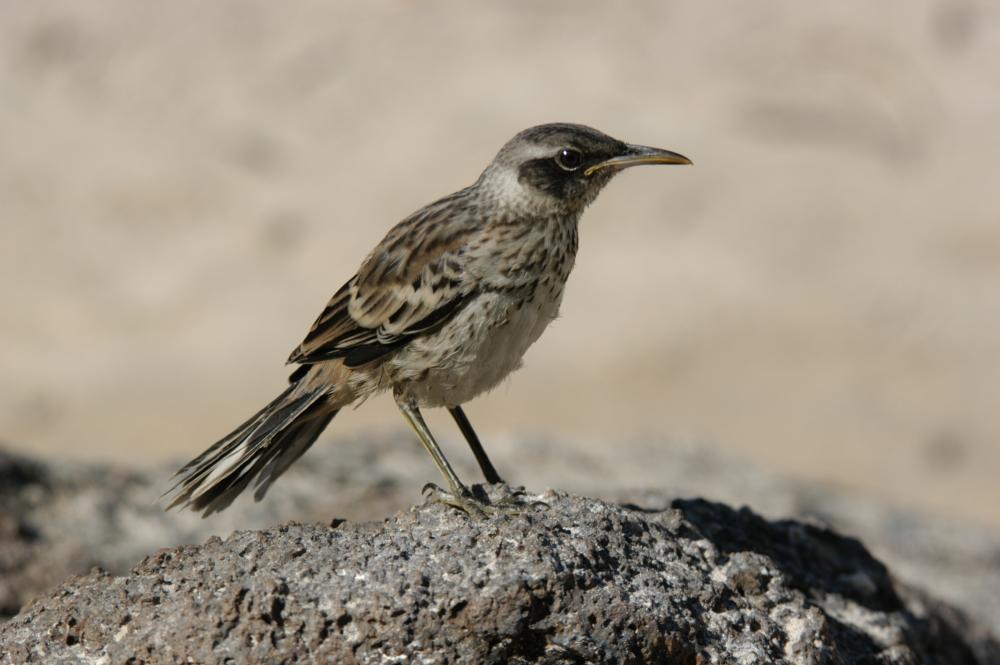Galapagos mockingbird
(Mimus parvulus)

Description
Mimus parvulus, commonly known as the Galapagos mockingbird, is a small bird species that is found only in the Galapagos Islands. As an expert in bird biology, behavior, and ecology, I will provide a detailed overview of Mimus parvulus, covering its physical characteristics, habitat, behavior, breeding, diet, and conservation status. Physical Characteristics The Galapagos mockingbird is a small passerine bird, measuring around 25 cm in length and weighing approximately 65 g. It has a grayish-brown body, with a long tail and wings, and a curved beak. The plumage is slightly darker on the head and back, while the underside is paler, with a white or buff-colored breast. The Galapagos mockingbird is sexually monomorphic, which means that males and females look similar. However, there are some variations in plumage among different populations on different islands in the Galapagos archipelago. Habitat The Galapagos mockingbird is endemic to the Galapagos Islands, a volcanic archipelago located around 1,000 km off the coast of Ecuador in the Pacific Ocean. The bird is found on most of the islands in the archipelago, including Isabela, Fernandina, Santa Cruz, and San Cristobal. The Galapagos mockingbird inhabits a variety of habitats, including arid lowlands, scrublands, forests, and highland grasslands. It is also known to live in urban areas, where it can be seen scavenging for food in trash cans and around human settlements. Behavior The Galapagos mockingbird is an intelligent and curious bird species. It is known for its unique behaviors, including tool use, which is rare among birds. The bird has been observed using twigs, cactus spines, and other objects to extract insects from tree bark or crevices. The Galapagos mockingbird is also known for its tameness and lack of fear of humans. This behavior is thought to be due to the isolation of the Galapagos Islands and the lack of predators, which has resulted in the birds having no natural fear of humans. Breeding The Galapagos mockingbird breeds throughout the year, with peaks in breeding activity during the wet season. The breeding pairs form monogamous relationships and build cup-shaped nests using twigs, grasses, and other materials. The nests are usually built in trees, shrubs, or on the ground, depending on the location. The female Galapagos mockingbird lays 2-4 eggs, which are incubated for around 14-15 days. Both parents take turns incubating the eggs and feeding the chicks, which fledge after around 15-17 days. The chicks remain with their parents for several weeks after fledging, during which time they learn essential survival skills and foraging techniques. Diet The Galapagos mockingbird is an omnivorous bird species, feeding on a variety of foods, including insects, fruits, seeds, and small vertebrates such as lizards and iguanas. The bird is known to follow other animals, such as giant tortoises or marine iguanas, to feed on the insects that they disturb. The Galapagos mockingbird is also known to scavenge for food in human settlements and around garbage dumps, which has made it vulnerable to human activities such as habitat destruction and pollution. Conservation Status The conservation status of Mimus parvulus, commonly known as the Galapagos mockingbird, is listed as a species of Least Concern by the International Union for Conservation of Nature (IUCN). This means that the species is not considered to be facing a significant risk of extinction in the wild in the near future. The Galapagos mockingbird has a relatively large population, and its range includes several protected areas in the Galapagos Islands, including the Galapagos National Park. Additionally, the bird is not currently facing any significant threats or major population declines. However, despite its current status, the Galapagos mockingbird is still vulnerable to potential threats, such as habitat destruction and pollution, which could have negative impacts on its population in the future. Conservation efforts, such as habitat protection and management, are still necessary to ensure the long-term survival of this unique bird species.
Taxonomic tree:







